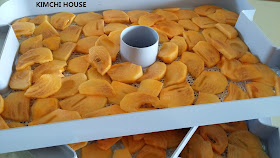Autumn is the harvest season for persimmons ~~ Persimmons are eaten fresh, dried etc. Today, I am going to share with you these persimmon chips. In Korean, we call persimmon as " Gam" and persimmon chips as " Gammallaengi"
秋季是柿子丰收的季节~~ 柿子可以拿来生吃或乾吃,等吃法。 今天,与您分享这柿子片。 在韩文,柿子的发音是 “Gam”,柿子片是 “ Gammallaengi"
Persimmons are eaten fresh, dried, raw, or cooked. When eaten fresh, they are usually eaten whole like an apple or cut into quarters, though with some varieties, it is best to peel the skin first. One way to consume very ripe persimmons, which can have a very soft texture, is to remove the top leaf with a paring knife and scoop out the flesh with a spoon. Riper persimmons can also be eaten by removing the top leaf, breaking the fruit in half and eating from the inside out. The flesh ranges from firm to mushy, and the texture is unique. The flesh is very sweet and when firm due to being unripe, possesses an apple-like crunch. American persimmons and diospyros digyna are completely inedible until they are fully ripe.
In China, Korea, Japan, and Vietnam after harvesting, 'Hachiya' persimmons are prepared using traditional hand-drying techniques, outdoors for two to three weeks. The fruit is then further dried by exposure to heat over several days before being shipped to market. In Japan the dried fruit is called hoshigaki (干し柿), in China it is known as "shìbǐng" (柿饼), in Korea it is known as gotgam (hangul: 곶감), and in Vietnam it is called hồng khô. It is eaten as a snack or dessert and used for other culinary purposes.
In Korea, dried persimmon fruits are used to make the traditional Korean spicy punch, sujeonggwa, while the matured, fermented fruit is used to make a persimmon vinegar called gamsikcho (감식초).
In Taiwan, fruits of astringent varieties are sealed in jars filled with limewater to get rid of bitterness. Slightly hardened in the process, they are sold under the name "crisp persimmon" (cuishi 脆柿) or "water persimmon" (shuishizi 水柿子). Preparation time is dependent upon temperature (5 to 7 days at 25–28 °C (77–82 °F)). In some areas of Manchuria and Korea, the dried leaves of the fruit are used for making tea. The Korean name for this tea is ghamnip cha (감잎차).
(source : Wikipedia )
Put the sliced persimmons on the dehydrator, to dehydrate ~~
将切好的柿子片放在食物烘干机上, 将柿子片风干 ~~
Should not chose those ripe and soft persimmons ~~
不应该选那些已熟或软绵绵的柿子~~





No comments:
Post a Comment